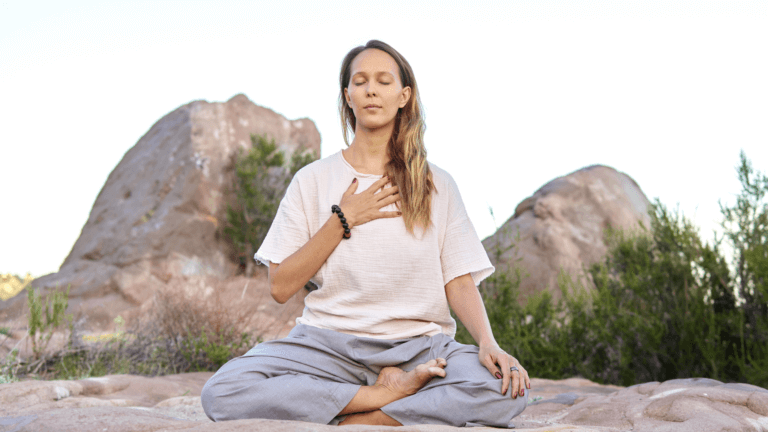
Yoga therapy is a relatively new healing modality, at least in the US. While yoga has been renowned for thousands of years for its transformative ability to create union and balance between the mind, body and spirit, but until recently, the outcomes have been largely anecdotal without evidence-based research to support these outcomes. In the last 30 years, we’ve begun to research and document why yoga works and how it integrates all the layers of being human – physical, mental, emotional and spiritual and recognizes how interconnected all of these are.
Based on this research, yoga therapy has been developed as the therapeutic application of the tools and practices of yoga including breath, meditation, movement, and mindfulness to address a specific condition. Yoga therapy is a self-empowering process that guides an individual toward their own health and healing.
Yoga therapy uses the biopsychosocial model of health and takes into account the physical, mental, social, and spiritual impacts on a person’s health, wellness, and healing.
Mental, Emotional and Physical Integration of Life’s Experience
Education, self-discovery, and nervous system regulation practices help us to discover that we are not defined by our experiences, diagnoses, or circumstances. While we can’t always change health outcomes, we can begin to have a different experience of living our lives with these conditions. We can find joy and peace in living our life’s purpose despite mental and physical challenges.
In yoga therapy sessions, what happened isn’t as important as what you feel (or don’t feel) in the body. With chronic stress and trauma, we can become disconnected from our bodies.
In yoga therapy, we focus on the feelings in the body, the actual physical sensations of your emotions, describing and allowing for these difficult emotions to pass through with curiosity and compassion. You learn to reconnect with and come back home to a sense of safety within your own body regardless of the emotions you are feeling.
Trauma survivors and anyone dealing with difficult life circumstances may have an especially hard time with “top-down” regulation of their autonomic nervous systems because their brain’s frontal lobe (rational thinking) cannot communicate with their amygdala (the fear and survival center).
We can begin to heal that connection through “bottom-up” regulation, connecting the body with the mind. A combination of simple movement, connected with the breath, can help those in a state of chronic stress to self-regulate so they can feel at peace in their bodies.
Yoga Therapy for mental, physical and emotional health
Because mental, physical and emotional health are all effected by chronic stress, and yoga addresses not only the physical experience of stress, but also the old patterns of thought movement and reactions that create stress and anxiety, we’re able re-teach the nervous system how to respond in situations where maladaptive patterns may have been creating more stress and anxiety. We can learn to have a different experience of the same old stressors and difficult experiences.
In doing this, yoga therapy can help address and improve a significant number of chronic health conditions, including: Addiction & Recovery, Anxiety, Autoimmune Conditions, Chronic Pain, Chronic Stress, Depression, Difficult Relationships, Difficult Life Circumstances, Disturbed Sleep, Grief and Post-Traumatic Stress.
Is Yoga Therapy Different From A Yoga Class?
Yoga therapy and yoga classes both involve practicing yoga, but they have different goals and approaches. Yoga classes are usually focused on fitness and general well-being with a yoga teacher instructing larger groups, while yoga therapy is personalized to address specific health conditions in individual sessions or small groups under the guidance of a trained therapist.
Instructors in yoga classes are certified yoga teachers, while yoga therapists have additional training in healthcare and work closely in collaboration with other healthcare providers to improve a patient’s physical, mental, and emotional well-being. Yoga therapy incorporates yoga tools and practices beyond the poses many of us are familiar with. Movement is used as a tool for reconnecting to the body and regulating the nervous system but often doesn’t include traditional yoga poses.
Is A Yoga Therapist Different From A Yoga Teacher?
All yoga therapists are also yoga teachers, but all you teachers are not yoga therapists. Yoga therapists have completed over 800 hours of instructional training AND over 200 hours of supervised clinical practicum hours while most yoga teachers have completed only 200 hours of instructional training.
Yoga therapy training includes the therapeutic application of yoga for chronic health conditions like diabetes, hypertension, nervous system disorders, and cancer care as well as mental health conditions like anxiety, depression, ADHD, post-traumatic stress, and more. After completing the required training hours and the practicum, yoga therapists are certified by the International Association of Yoga Therapists (IAYT).
At ZoeRVA, we provide yoga therapy and firmly believe that harmonizing the body, mind, and spirit can enhance the efficacy of your therapy sessions, leading to greater success.
Ali Webb, C-IAYT, E-RYT 500, YACEP is a certified yoga therapist and trauma-informed yoga teacher, dedicated to empowering individuals through the transformative practice of yoga. Ali’s approach integrates nervous system regulation tools like breathwork, gentle movement, and meditation. Her programs are designed to address anxiety, chronic pain, depression, addiction, PTSD, and other challenging conditions. Schedule a free discovery call to see if yoga therapy is the next step on your healing journey.










